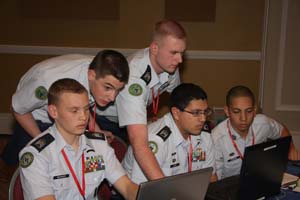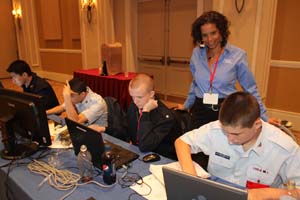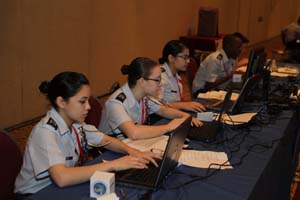CyberPatriot is scaling up. The Air Force Association’s innovative high school cyber security competition has new corporate sponsors and big plans for expansion in the 2010-11 school year.
The first two rounds of CyberPatriot games, held in February 2009 and 2010, featured teams of teenagers drawn from Air Force Junior Reserve Officer Training Corps and Civil Air Patrol units. In the upcoming round, JROTC members from all services and interested teams with no military affiliation will also be eligible.
“We want to reach the broadest possible demographic,” S. Sanford Schlitt, AFA Vice Chairman of the Board for Aerospace Education, said at a May 12 event at the National Press Club in Washington, D.C. Registration for the competition began the next day.
A grant from Northrop Grumman has helped make possible this step to full nationwide deployment. Raytheon has also joined the effort as a CyberPatriot strategic partner.
Every year, US youth are exposed to more and more complicated technology—and more and more complicated cyber threats, noted Diane G. Miller, director of operations for Northrop Grumman’s Cyber Security Group and CyberPatriot program manager.
CyberPatriot intends to teach students how to fight back against electronic adversaries. “Defending and protecting our cyber-enabled world is a national priority,” said Miller.
CyberPatriot is patterned after the National Collegiate Cyber Defense Competition. The founder of the college-level contest, Gregory B. White, is the director of the Center for Infrastructure Assurance and Security (CIAS) at the University of Texas, San Antonio. He served 19 years on active duty with the US Air Force and recently retired as a Reserve colonel.
 |
|
At CIAS, White has run college-level security competitions for years. He had long thought that younger tech-oriented teenagers would be enthralled by playing in their own competition. With lots of help from AFA, White found out he was right.
AFA saw CyberPatriot as an aerospace education initiative with the potential to have a national impact. Beginning in 2008, AFA pulled together money, equipment, and expertise to set up the first round—CyberPatriot I—in just 12 months.
This initial competition, held in 2009, was a prototype event. It drew in eight high school teams from Air Force JROTC and CAP units located close to the Orlando, Fla., site of AFA’s annual Air Warfare Symposium.
Organizers did not really know what to expect—in particular, the extent to which the contestants would truly engage with the challenge presented to them. They worried that the teenagers would find the computer security challenges to be too hard or, worse, just dull.
They needn’t have been concerned. The kids were so involved in the competition that when Team Spaatz from Osceola High School in Kissimmee, Fla., was named the winner, people heard the cheering in the next hall.
“You’d have thought it was the finals of the Olympics,” said AFA Chairman of the Board Joseph E. Sutter.
CyberPatriot II built on this success. It brought together more than 200 five-member AFJROTC and CAP teams from 44 states and Japan. After three online qualification rounds, the eight surviving finalist teams competed in the championship round, held in February in Orlando.
This time, the winner was AFJROTC Team Doolittle from Clearfield High School, Clearfield, Utah. CAP Team Curry from Burlington, N.C., came in second, and CAP Team Cochran from Torrance, Calif., finished in third place.
“This was a great learning opportunity, and just a lot of fun for the teams,” said Kit K. Workman, Team Doolittle’s coach, following the February victory. “They worked hard, and it was exciting to see them rapidly gain skills. They are definitely more interested in the cyber security career field as a result.”
CyberPatriot

In one division, the competition will feature some 500 JROTC and CAP teams, while in another, 500 unaffiliated students will compete. Teams in both divisions will work through parallel online training and qualification rounds to pick finalists for an in-person showdown at the new AFA CyberFutures Conference, scheduled to take place in April 2011 at the Gaylord National Resort & Convention Center at National Harbor, Md., near Washington, D.C.
Tens of thousands of teenagers ultimately will be involved in this competition, said AFA officials. Win or not, they will gain exposure to the vital and fast-growing field of cyber defense technology, at an age when many youths are beginning to think about the direction of their careers.
“The Air Force certainly needs more cyber defenders, and it’s important to the nation as a whole,” said Sutter. “CyberPatriot excites, it motives, and it teaches.”
AFA intends to recruit teams by asking members in its chapters around the nation to spread the word at the grassroots level. As a presenting sponsor, Northrop Grumman will provide both funds for CyberPatriot expansion and expert employees to train and mentor participants.
This year, the contest will open with a new and expanded online training component. This will both teach participants principles of general computer security awareness and prepare them for the specific competitive task they’ll face.
Science Applications International Corp.—a founding partner—will provide the competition platform. The contest will begin when a team downloads a software-created image of a server, a “Virtual Machine,” which is connected to a scoring server at SAIC. This scoring server is part of SAIC’s CyberNEXS commercial cyber defense trainer. As the competitors will soon find out, this Virtual Machine is flawed. The team’s job is to fix it.
Half the teams will proceed to a second round, which will feature a more complex online problem. Subsequent rounds will reduce the competitors, until 17 teams remain. These teams will win trips to the CyberFutures Conference and the final showdown.
It is no secret that the US needs more cyber defenders—and soon. The nation’s networks face persistent attacks, including complex criminal hacker schemes, and cyber espionage from China and other nations.
And the US is in the position of defending the most cyber “coastline” in the world. It has the world’s largest economy and most advanced military, and both are highly dependent upon the smooth operation of networked computer systems and databases.
“We’d become debilitated if they were out of use,” noted Northrop Grumman’s Miller.
 |
|
That is one reason Secretary of Defense Robert M. Gates ordered the creation of US Cyber Command, a subunified command that falls under US Strategic Command. The new unit reached initial operational capability on May 21.
“This command is not about efforts to militarize cyberspace; rather, it is about safeguarding the integrity of our military’s critical information systems,” said Army Gen. Keith B. Alexander, Cyber Command commander and director of the National Security Agency, at his confirmation hearing in April.
In this field, safeguarding is more difficult than attacking, note experts. Hackers only have to find one chink in a system’s cyber armor to do their damage. Defenders must mount a broad effort that takes into account the way hackers work, even as they struggle to keep systems up and in business.
CyberPatriot organizers note that they teach defense, not offense. “It is not a hacker competition,” says AFA’s Schlitt.
Instead, CyberPatriot aims to use its game-like format to excite US youth and get them into a career field in which the US will need tens of thousands of new specialists a year for decades to come.
Peter Grier, a Washington, D.C., editor for the Christian Science Monitor, is a longtime defense correspondent and a contributing editor to Air Force Magazine. His most recent article, “Science Right From the Start,” appeared in the March issue.
